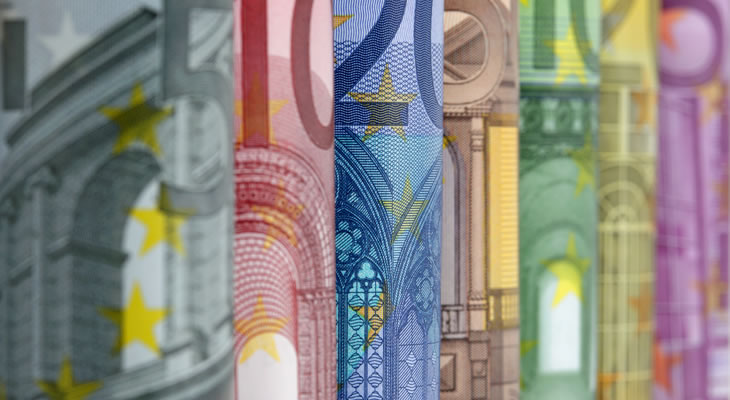- Eurozone sentiment rebounded in August to boost Euro – Limited impact of Brexit uncertainty encouraged investor confidence
- Fed rate hike bets dented by less hawkish July meeting minutes – Markets reduced odds on possibility of 2016 monetary tightening
- ECB remained in ‘wait and see’ mode – Central bank forecast to maintain neutral bias in near term
- EUR USD exchange rate predicted to trend higher – Lower likelihood of policy divergence expected to shore up Euro
The latest meeting minutes of the Fed and the European Central Bank helped to boost the Euro US Dollar exchange rate on Thursday, but can the single currency maintain its gains amid market speculation?
Minimal Impact of Brexit on Eurozone Sentiment Boosted EUR USD Exchange Rate
Although the start of the week had seen an increase in bets that the Federal Reserve would raise interest rates before the end of the year, this failed to keep the Euro to US Dollar (EUR USD) exchange rate on a weaker footing. The US Consumer Price Index for July did not offer much encouragement to investors, with the domestic inflation rate weakening further than forecast from 1.0% to 0.8% on the year. This undermined confidence in the robustness of the world’s largest economy, even though members of the Federal Open Market Committee (FOMC) maintained a more hawkish tone with regards to monetary policy.
The appeal of the Euro (EUR) has been shored up by indications that the UK’s vote to leave the EU has had a minimal impact on domestic sentiment. After the Eurozone ZEW Economic Sentiment Survey strengthened far further than anticipated, from -14.7 to 4.6, markets were inclined to view the single currency more favourably. Although other fresh domestic data has been somewhat limited, investors have been taking a more optimistic view of the currency union’s outlook, supporting the EUR USD exchange rate further.
ECB Predicted to Maintain Neutral Outlook, EUR USD Exchange Rate to Trend Higher
Investors gained more of a view into the mind-set of the European Central Bank (ECB) thanks to the account of the July monetary policy meeting. Policymakers expressed a desire to convey a message of ‘cautious optimism’ regarding the outlook of the Eurozone economy, with President Mario Draghi having chosen to talk down the prospect of further monetary loosening in comments to the media. The mood certainly seemed to favour a ‘wait and see’ approach, with the minutes noting:
‘It was widely agreed that the immediate policy focus should remain on implementing the comprehensive set of policy measures decided in early March and on preserving an appropriate degree of monetary accommodation in order to secure a return of inflation rates towards levels below, but close to, 2% without undue delay. There was solid evidence that the policy measures that had been adopted were effective and were working their way through to the broader economy over time.’
This suggests that the ECB is unlikely to return to an easing bias any time soon, something that should help support the Euro. Of course, the outlook of policymakers remains closely tied to domestic data, so any persistent weakness in upcoming ecostats could undermine this assessment. While sentiment has largely recovered in the wake of the Brexit vote downside pressures remain, particularly as the German economy is continuing to carry the brunt of the currency union’s growth. Further signs of softness within the French or Italian economies could well set the EUR USD exchange rate on a renewed downtrend.
US Dollar Forecast to Remain Volatile on Fed Rate Speculation
Investors were not impressed by the level of division evident amongst policymakers in the minutes of the July Federal Open Market Committee (FOMC) meeting. The more dovish prevailing tone prompted the US Dollar to slump against rivals, with markets dialling back on the pricing of a 2016 interest rate hike from the Fed. This mood was exacerbated by words from St Louis Fed President William Dudley, who repeated his opinion that only one rate hike would be appropriate over the next two years. Altogether this does not suggest that investors should expect the Fed to act again in the near future, though Kit Juckes, economist at Societe Generale, noted:
‘I’m still sure that the FOMC would like the market to price a bit more in, but only because when they finally act, they don’t want the Dollar to go up too much (if at all) and risk sentiment to suffer too much (if at all).’
Should domestic data continue to paint a less-than-robust image of the world’s largest economy markets are likely to be less willing to price in a near term interest rate hike. This could see the US Dollar remain on a weaker footing against its rivals, with the safe-haven also weighed down by any improvements in market risk appetite. If the latest ecostats prove more positive, though, the EUR USD exchange rate could struggle to hold onto a bullish trend.
Current EUR, USD Exchange Rates
At the time of writing, the Euro to US Dollar (EUR USD) exchange rate was trending higher in the region of 1.1312, while the US Dollar to Euro (USD EUR) pairing was slumped around 0.8837.


Comments are closed.